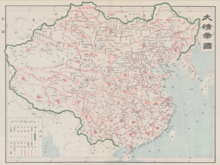|
Administrative divisions of the Qing dynasty
   The Qing dynasty was a Manchu-led imperial Chinese dynasty and last imperial dynasty in Chinese history. The administrative system of the Qing dynasty was based on the idea of "adapting to the times and the place, and making adjustments according to circumstances".[1] The Interior ProvincesInitiallyInitially, the Qing dynasty expanded the Ming province system from 15 to 18 provinces, with the interior of the Qing dynasty comprising Beijing (the capital city) and these eighteen provinces (also known as China proper). During the Late QingDuring the late Qing dynasty, there were efforts to extend the province system of China proper to the rest of the empire. Xinjiang was reorganized into a province in 1884 and later Manchuria was split into the three provinces of Fengtian, Jilin and Heilongjiang in 1907. Taiwan was converted into a separate province in 1885, but was then ceded to Japan in 1895 following the First Sino-Japanese War. There was discussion to do the same in Inner and Outer Mongolia and Tibet-Qinghai, but these proposals were not put to practice, and these areas remained outside the provincial system of China proper when the Qing dynasty fell. Governance over the ProvincesUnlike the Ming provincial administration which consisted of three governors the Qing provinces were governed by a single Governor or "Xunfu (巡抚)" who held substantial power. Although all provincial agencies communicated with the central government through him, he himself was subordinate to a Governors-general "Zongdu (总督)". While nominally superior to a Governor, usually the Governors-general cooperated closely with the Governor and acted jointly in reporting to the central government.[2] Under the authority of the Governors were two types of agencies: the Provincial Administration Commissions and the Provincial Surveillance Commissions. The Provincial Administration Commissioner, acting as a lieutenant-general, handled financial duties. The Provincial Surveillance Commissioner managed judicial and oversight functions. Additionally, each province had an unofficial Provincial Education Commissioner who oversaw educational institutions and certified candidates for the civil service exams. Circuit Intendants, known as "Daotai (道臺)" operated within the provincial administration as liaisons between the prefectures and the provincial authorities.[3] RegionsChina in the Qing dynasty was divided into five major regions: The Interior (Beijing and eighteen provinces), Guandong (Three Eastern Provinces), Xinjiang (Chinese Turkestan), the Mongolian steppe (Inner and Outer Mongolia), Qinghai and Tibet.[4] The Qing government agency known as Lifan Yuan oversaw the administrations of the empire's Inner Asian territories, which were also collectively known as Chinese Tartary by contemporary Europeans. Tributary States and VassalsThe Qing dynasty had a total of approximately 19 tributary states and a few vassals (not all at the same time) under the traditional tributary system of China.[5]
See also
References
|